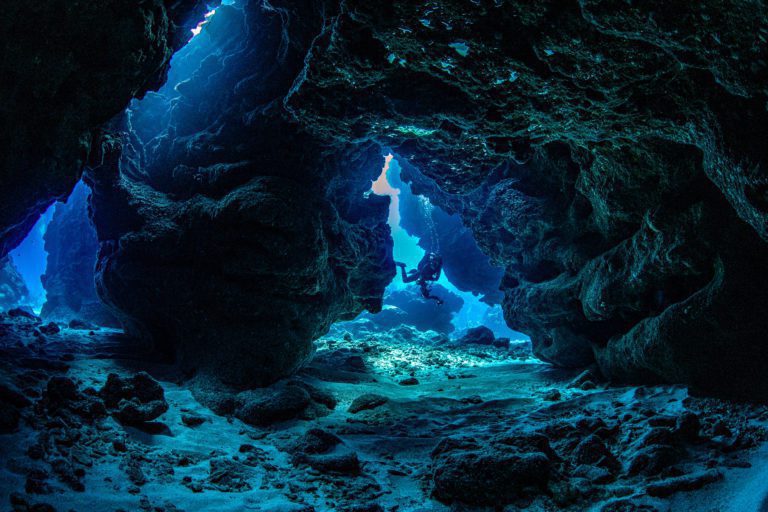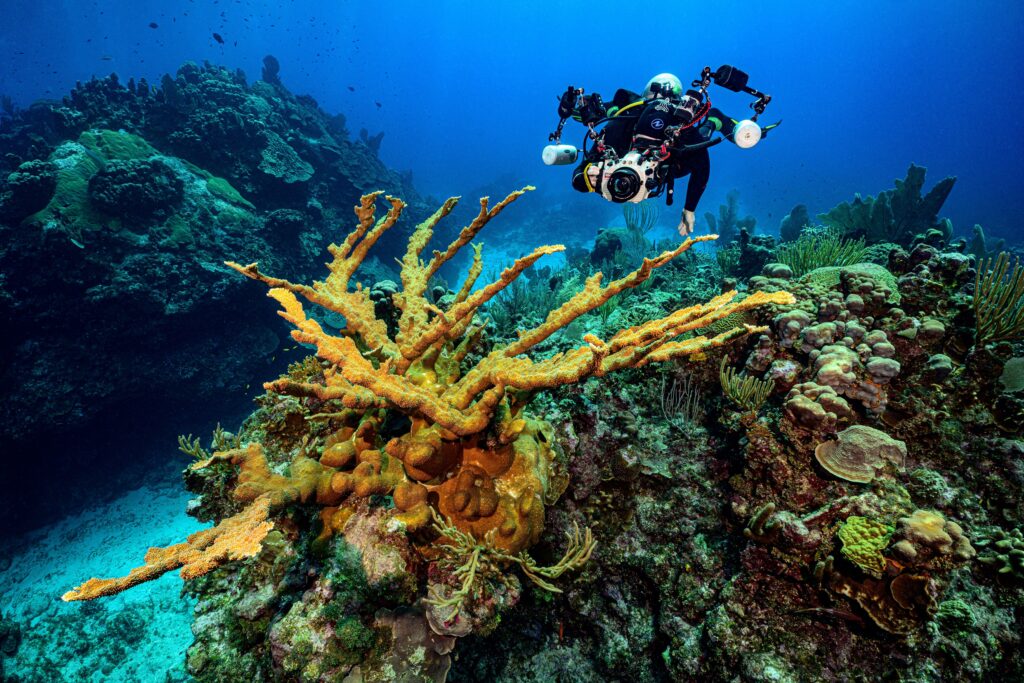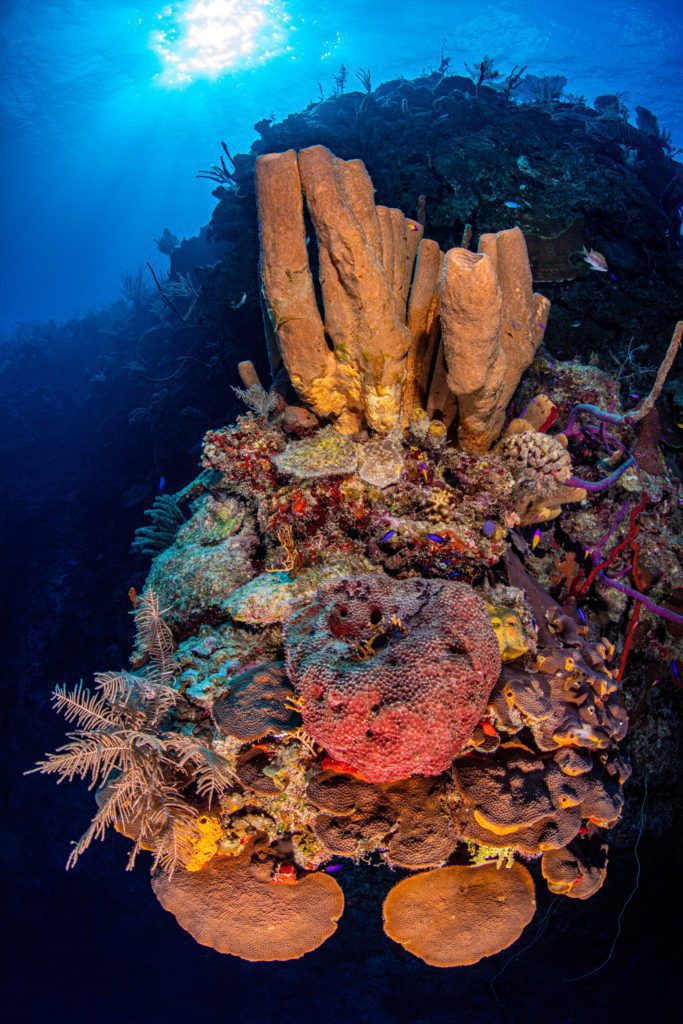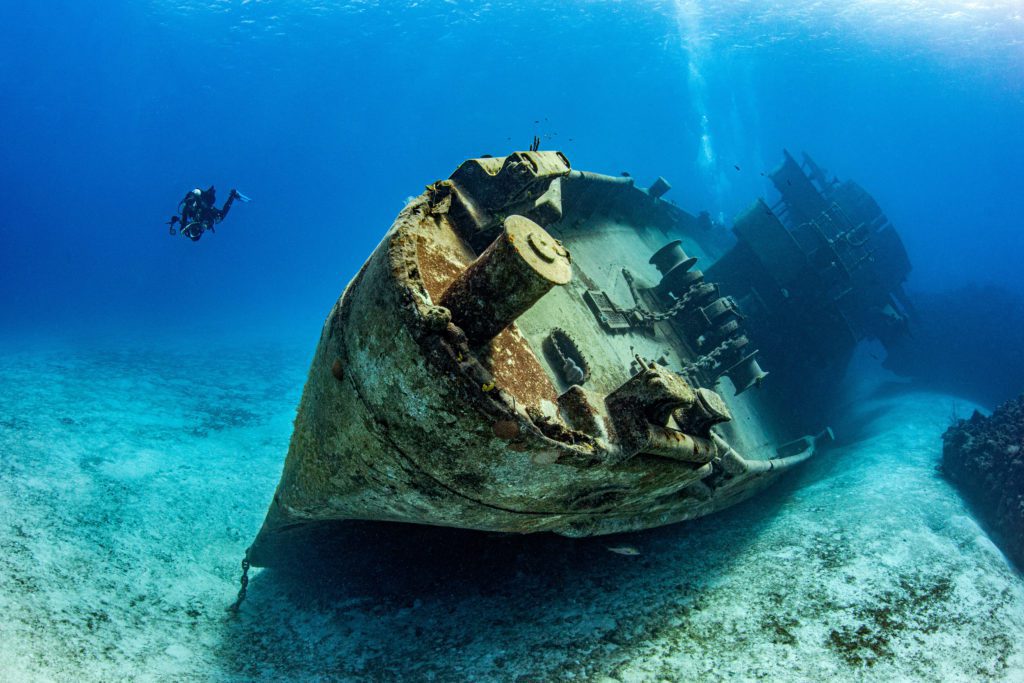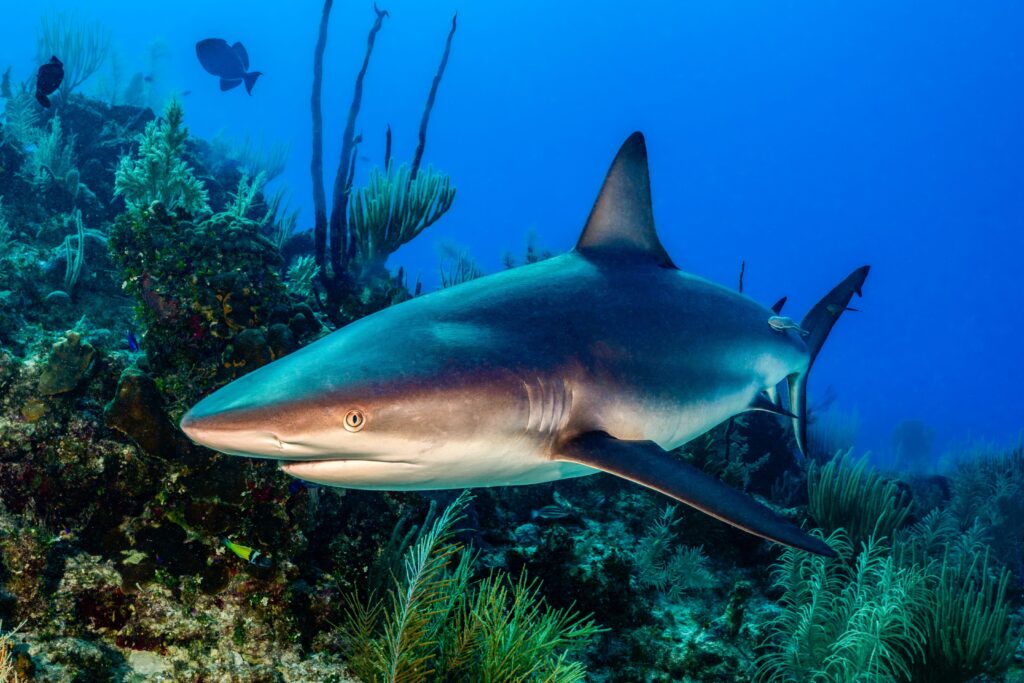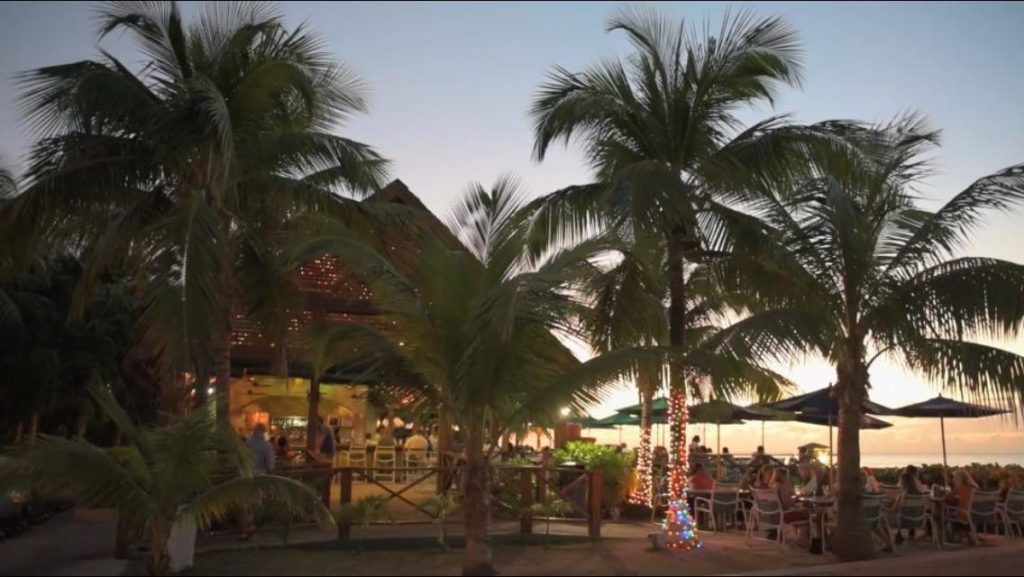BYRON CONROY discovers the Caribbean dive-destination of his youthful dreams when he gets round to exploring the waters around Grand Cayman
There are three Cayman Islands in the Caribbean, and the largest is Grand Cayman, 21 miles long and eight across at its widest point. Seasonal air and water temperatures don’t vary much, making it a year-round warmwater dive location.
Grand Cayman a population of only 67,000, around 40,000 of whom live in the capital George Town. This makes the coastal areas scarcely populated and relaxing. The economy benefits greatly from tourism and justifiably because some of the Caribbean’s most pristine dive-sites can be found there, with healthy reefs, big-animal encounters and wrecks all awaiting visiting divers.
Grand Cayman arrival
I flew in using the local transport provider Cayman Air from Tampa, Florida, and was greeted by friendly locals at the airport. The islands are an autonomous British Overseas Territory, which imparts something of a colonial with the Caribbean atmosphere. English is the language of the islands.
After settling into my accommodation and taking a short wander around it was time to find out more about the diving on offer. There are two particularly famous sites, the Kittiwake wreck and Stingray City. Photos of these two locations have adorned the covers of magazines and diving calendars for years and we would be taking in both during the visit.
The island was also known for having for a good population of elkhorn coral (Acropora palmata) until Hurricane Ivan struck in 2004 and pretty much destroyed all the elkhorn and sponges as it swept through. The coral and sponges have been left largely undisturbed since then, and as a result there is now a wide range of subjects all of similar size around the islands.
Mouthbrooders on check-out
Caught out by a bit of bad weather, we were faced by some of the more desirable sites being out of reach because of waves breaking on the reef around the resort, so we headed to Sunset Reef for the check-out dives. The reef turned out to be home to some interesting supermacro critters.
One of the large boulder corals was full of small holes and patience was rewarded when a little golden rough-head blenny poked its head out to make an appearance. Its expressive face was very photogenic.
The other highlight of the dive was an elusive yellow-head jawfish – with eggs in its mouth. These fish can be found in the white sand but are difficult to approach to shoot. Much time and patience is needed as you inch towards the subject, or it will shoot back into its hole and not re-emerge for another 5-10 minutes.
The fish carry their eggs in the mouth until they’re ready to hatch. When they pop out from their hole, they are sometimes feeling the need to aerate the eggs, and do so by spilling them out to wash in the water column.
Double Babylon
On our second day of diving the weather had calmed a little, so we were able to make our way through the breakers on the reef and head to the most famous wall-dive on the island, Babylon.
The wall is where the main reef drops off into the deep blue water. The boat was moored and after descending to the reef-wall top I peered over the edge into the wonderful clear warm water and into the abyss.
This wall site is one at which you can easily go into deco. The water is so inviting and clear that you can easily be at 40m and still see the boat at the surface. The walls are filled with large sponges and colourful corals, along with cracks and canyons through which you can easily fit. Conditions were so good for the Caribbean that we conducted both morning and afternoon dives at the same location.
Stingray City
We were planning for a long day – Stingray City for the morning sunrise followed by morning and afternoon dives on the Kittiwake.
Stingray City is located off the coast and is very shallow at less than 4m. It’s home to around 50 rays that range up to almost 2m wide. The area is well-managed with boats arrived in pre-arranged time-slots, keeping the amount of visitors at any one time to manageable levels.
The guides feed the rays squid so there are always many rays and lots of action. We went to the nearby Sand Bar, which has plenty of ray action also but is only a few feet deep. You’re not allowed to scuba there, and shoes are not allowed, to protect the sand as much as possible.
Sunrise is a great time to shoot the sting rays – 50/50 or over/under shots using camera lights can look good with a sunrise peeking above. Unfortunately we didn’t enjoy the best of sunrises, but once the sun was up we had good conditions in which to shoot.
A rash-vest and shorts are best for this undertaking, to make sure you can duck to sand level and shoot the rays as they sweep past. We stayed at the location for a few hours and the time flew because of the non-stop action.
The Kittiwake
After our time slot was up, we headed over to the Kittiwake. The wreck is a decommissioned submarine rescue ship that used to accompany subs during sea trials and manoeuvres. Crew would monitor operations and practise underwater rescue drills. The ship was also often used on underwater salvage operations to support divers and crew.
The vessel had a rich history, with many of its operations still classified to this day. One of its more famous exploits came when it took part in the 1986 Challenger space shuttle rescue operation – it was the Kittiwake’s crew that recovered the lost “black box” and the vital information it carried.
Kittiwake served divers during its topside career so it’s fitting that the wreck has become a Mecca for divers. It is also filled with interesting items such as a hyperbaric chamber and many of the “bank” tanks used to store the compressed gases that once supplied the divers and hyperbaric chambers onboard.
The depth of the wreck is ideal for those venturing into wreck-diving for the first time but also for more experienced divers to be able to conduct long dives. It sits at 20m, with some features reaching to less than 5m below the surface.
The wreck also lists slightly to one side. It used to be upright but was hit pretty hard by a hurricane that tipped it and also moved it sideways across the sand closer to the reef.
We were lucky enough to dive the wreck twice on one visit, on morning and afternoon dives with distinct sun conditions – one allowing natural light to fall onto the bow and the other on the stern. Because of the clear water and bright sun, it’s very easy to get a colourful, nicely exposed picture of the wreck in all its glory – perfect for the “big shot”-type external photo.
The wreck is filled with marine life including jack, barracuda and many macro subjects such as garden eels and mantis shrimps. The site is privately owned so a dive permit is needed to dive it, costing US $10 per visit.
Iron Shore Gardens
Over the following days we explored a mixture of famous sites, including Babylon again and others less well known. One of my favourites was Iron Shore Gardens, where we were lucky enough to have quite a few sightings of Caribbean reef sharks. They are doing well in the area, and it wasn’t uncommon to see 2.5m specimens swimming on the reef edge in the blue water.
This area is also home to a nice school of jack hanging in the shallow water on top of the reef. This is also where you will find some of the finest examples of Acropora palmata in the Caribbean, if not on the planet. Some of these corals are well over 3m wide and provide somewhere for small schooling fish to hide from passing predators.
Another personal favourite site was Chubb Hole. This has some very nice coral caves and overhangs, similar to Iron Shore Gardens, creating wonderful spaces that look dark and mysterious, but where natural light shines through. Also often hiding in the coral caves are tarpon – large silvery fish with menacing faces. They often lie relaxing in the caves and if you are equally calm they will allow you to approach them very closely.
Grand Cayman is home to quite a few well-known underwater photographers and I can see why. There is a wide variety of diving on offer in benign conditions, with great visibility and warm water. I had dived in the Caribbean quite a lot but it had not always lived up to the expectations of a dream destination I had as a child, but Grand Cayman was much closer to what I had dreamt of then.
Sunset House
Sunset House has been welcoming divers for more than 60 years. Its claim was always that it was the only resort in the Cayman Islands designed and operated by divers for divers. It’s also one of the only resorts on Grand Cayman with its own coral reef, with the wreck of the Nicholson and a coral nursery in shallow water just offshore.
Underwater visibility on the reef can exceed a claimed 60m, revealing a remarkable variety of marine life. The spectacular 2.5m bronze sculpture of the mermaid Amphitrite marks this popular shore-dive site.
The resort is set on a coastal road three-quarters of a mile south of George Town. It’s only 10 minutes from Owen Roberts International Airport, so you can be in your room and out for a dive within an hour of leaving the airport!
Accommodation is spacious and comfortable and the guest-rooms are spread out among a quintet of two-storey buildings, including a restaurant, dive-shop and thatch-roofed outdoor bar.
Options range from courtyard rooms to family apartments but most popular are the ocean-view rooms. Rooms have TV, wi-fi, air-con, bathrooms, fridge, coffee-making facilities, patio or balcony, and ocean-view rooms have microwaves.
The Sea Harvest restaurant by the pool serves breakfast, lunch and dinner and boasts a beautiful outdoor patio for evening dining. It is also close to the dive shop and complimentary dive-lockers, so you can transfer easily from breakfast to boat in the morning.
Lunch and dinner are also offered at the popular island hang-out My Bar, a huge open-sided cabana at the water’s edge at Sunset House that provides the best vantage point for watching – sunsets. Go early to get a good spot and order the infamous Mudslide if not your favourite libation. Then sit back and prepare to be overwhelmed by Mother Nature’s beauty.
Photographs by Byron Conroy |
Also on Divernet: Seven Miles High, Chain Of Women, All Three In A Row
